The HFS CrashPlan Cloud Backup Service
Single-user machine backup for desktops and laptops
Introduction to CrashPlan
CrashPlan (previously known as Code42) is the recommended tool for securing backups of university data on personal, single-user computers like your desktop and laptop at work and at home. It is a GUI-based product that backs up to the Cloud with many benefits including frequent automated backups in the background, unlimited storage and multiple file versioning allowing point-in-time restores.
The CrashPlan Cloud backup service is best suited to backing up single-user machines, or machines where a single user can take ownership of the backups (the HFS Storage Protect Backup Service may offer an alternative solution, subject to its own qualifying criteria).
System requirements
CrashPlan is fully supported by the vendor on reasonably recent versions of Windows, macOS, Ubuntu and Red Hat Enterprise Linux. Note however that there is a difference between fully supported and whether it works. In practice CrashPlan will continue to work, at least for a while, on older operating systems when they fall out of support although you may not get upgraded to the latest version of the software, and it will work on many more distributions of Linux. New operating system releases are often supported within a month, but are unlikely to be supported immediately. If you are considering upgrading your operating system we suggest you check here whether it is yet supported.
CrashPlan publish an official list of supported operating systems which may be more up to date or detailed than the information below so do consult it.
CrashPlan generally works best when installed with admin rights so it has access to all files. However if you do not have admin rights on your computer you can install for your own user only.
Windows
Windows 11 and 10 are supported while the operating systems are supported by Microsoft. This means if you are more than a couple of years out of date in updates neither Windows nor CrashPlan will be supported though CrashPlan may well continue to work. CrashPlan is a desktop/laptop backup product so Windows Server versions are not supported.
CrashPlan is known to still work on Windows 8.1 and the last supported version (which is branded as Code42) can be installed on these using the HFS Hub.
macOS
CrashPlan is supported on both Intel and Apple Silicon processors on systems running currently supported versions of macOS. Currently these are Tahoe, Sequoia, and Sonoma.
CrashPlan is known to still work on Ventura, Big Sur and Catalina and the last supported version can be installed on these using the HFS Hub.
CrashPlan is also known to still work on Mojave and High Sierra and the last supported version (which is branded as Code42) can be installed on these using the HFS Hub.
Linux
As always Linux is more complicated due to the enormous number and variety of distributions some of which are more similar to each other than others. In common with other vendors (including IBM with Storage Protect) CrashPlan officially support only certain 64-bit distributions which are Ubuntu long term support versions and Red Hat Enterprise Linux (RHEL), both of these for still supported versions of the distribution. Currently this is Ubuntu 22.04 and 24.04 and RHEL 8, 9 and 10. As regards other distributions:
- Distributions that are based on RHEL such as CentOS, AlmaLinux, Rocky Linux are likely to work
- Distributions based on Ubuntu such as Linux Mint, Zorin OS, Elementary OS are likely to work
- We have found that it also works on various other distributions based on Debian or RPM packaging
If CrashPlan support is a priority for you, you may wish to take that into account in your choice of distribution. If you find that CrashPlan will not work on your choice of distribution you may have better luck with Storage Protect. Although it has a similar limited official support list we find that in practice it does work on a wide range of newer and older distributions.
Installing the HFS CrashPlan App
Installation of the CrashPlan app is a simple two-stage process: First you download the HFS Hub and install that. This then manages the installation and configuration of the CrashPlan backup app. So, the first step is to download and install the HFS Hub following the instructions on the HFS Hub page.
Once the HFS Hub is installed run it and you will see the following screen, showing an option to install CrashPlan (assuming it is not already installed).
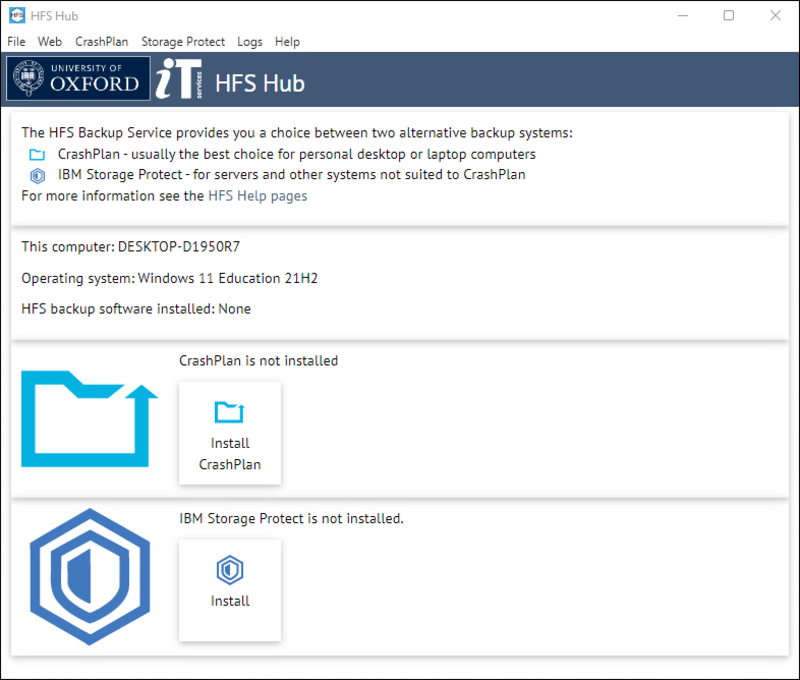
Choose the Install CrashPlan button in the centre of the window. The next screen will inform you that you must log in with your SSO (unless you have already done this). This is so that we can confirm you are eligible to use the service and also so we can create an account for you on the CrashPlan servers. Click the Login button and a browser window will open. If you have already logged into your browser you may need to do no more, but otherwise log in as you usually do. Once you are logged in go back to the HFS Hub where you will be asked to confirm you want to start CrashPlan installation. Do this by clicking on the Start installation button.
The correct version of the CrashPlan software for your computer will now be downloaded (unless you have already done this step).
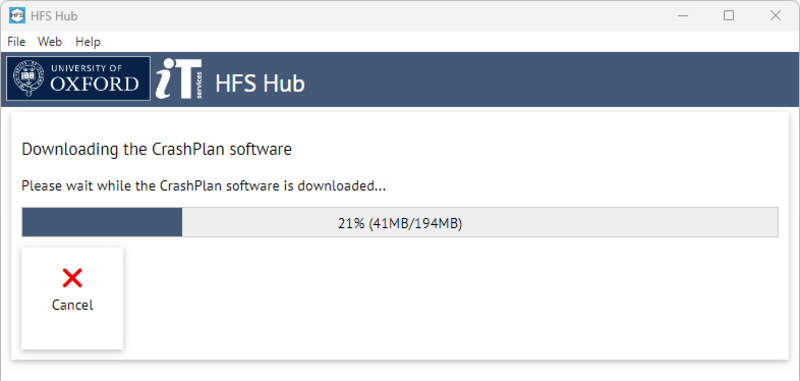
When the download completes this screen will change confirming the download has completed and will ask you to proceed to the next step. Click on the Next button and at the next screen the Start installation button.
On Mac and Linux (and on Windows if you do not have admin rights) you will be prompted for credentials to run the CrashPlan installer. The installer will run and when it completes CrashPlan should start up (in rare circumstances it does not - if it has not started after a while start from the Start Menu/Launcher etc.). You will see the Sign in to CrashPlan screen:
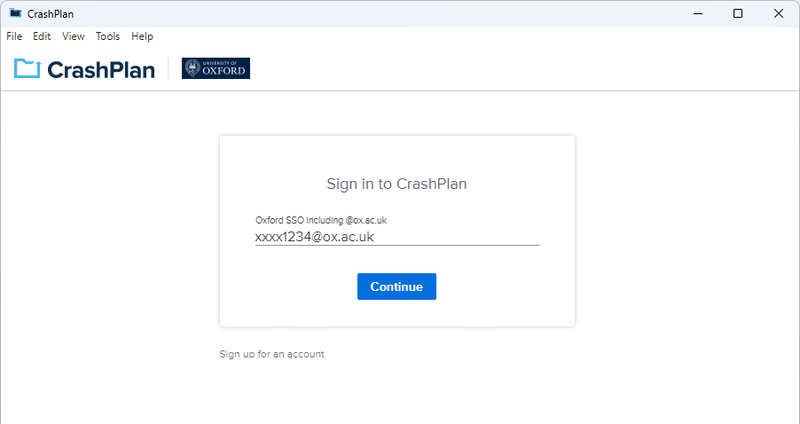
Usually your SSO will have been automatically filled in by the HFS Hub. If it has not been then enter it.
On rare occasions you might see a field labelled Server Address. If so enter clients.eu5.cpg.crashplan.com.
Now click 'Continue'. The CrashPlan app will now tell you to complete login to CrashPlan in your browser

As you have already logged into the HFS Hub using your browser you will not need to enter your credentials again. Please be patient and allow the login process to complete.
Once you have logged in, if you have already used CrashPlan the first dialogue screen will now offer you the choice of registering this machine as a new device or as a replacement device for one of your other machines. You will normally choose the 'New Device' option. (If your current machine is indeed a new replacement for another machine that has failed and for which CrashPlan backups exist, choose the 'Replacement' option and follow the prompts.) If you are installing CrashPlan for the first time on your one and only device, you should not be prompted as above.
The CrashPlan home screen will now display and is ready for you to make a selection for backup (note: by default nothing is included). A further note: If you have a large amount of data to back up initially, at least 1 TB or more, then please see the items 'The CrashPlan backup is very slow. How can I speed it up?' and 'The estimated time to completion for my initial backup is ridiculously long. Can I speed it up?' on the HFS FAQ page.
Note that on a Mac you may be interrupted by the following request to grant CrashPlan access to your personal files.
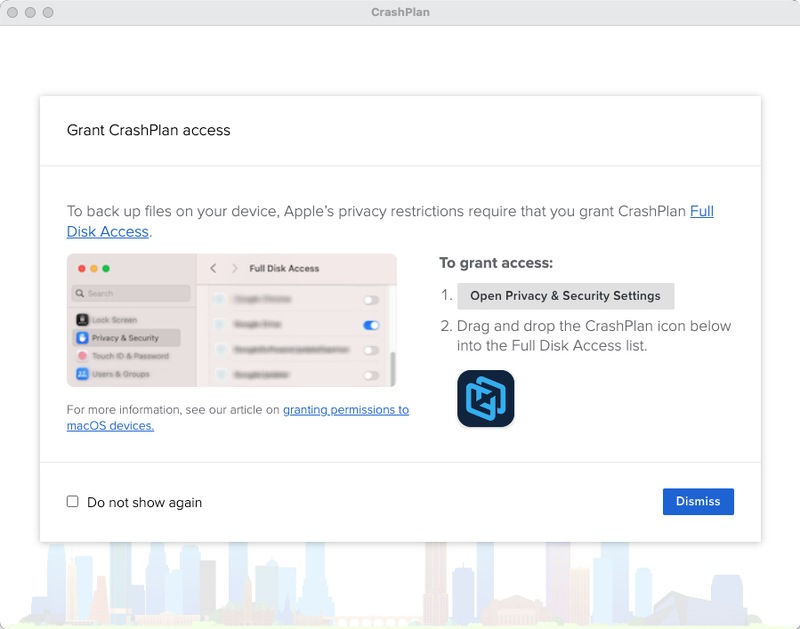
This is important. If you do not do this CrashPlan will not be able to back up all your files. Click the "Open Privacy & Security Settings" button. This should open System Settings at the Full Disk Access page. Drag the CrashPlan icon to this page. You will then see
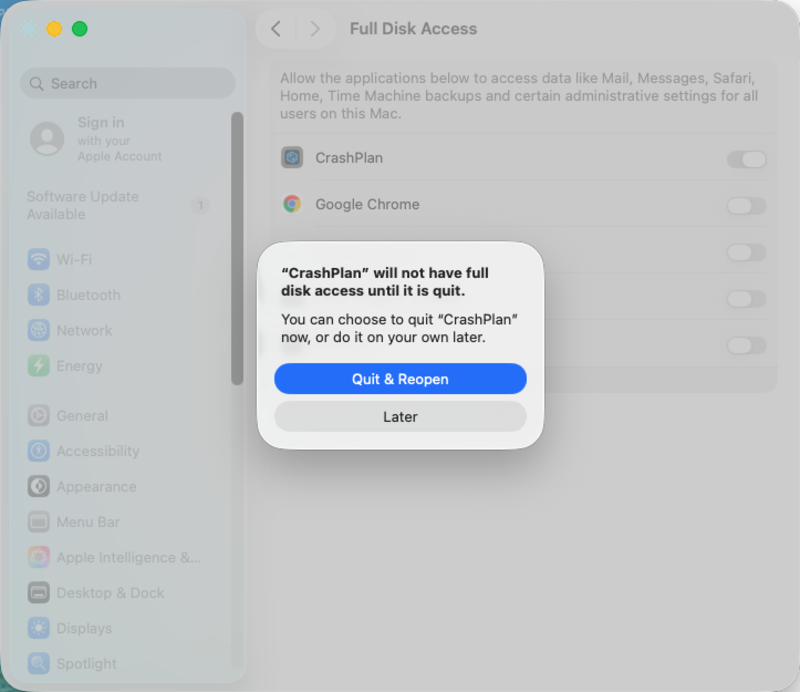
Quit and reopen CrashPlan. When it reopens continue from where you were. If you have problems with this, click the link to be taken to instructions on granting permissions to macOS devices.
A brief introduction to the CrashPlan interface is available on our Getting Started with CrashPlan page. Extensive online support on using the CrashPlan app is available from the CrashPlan support pages. Common questions around the Oxford implementation of CrashPlan backup may be answered on our HFS FAQ page.
Get support
If you cannot find the solution you need here then we have other ways to get IT support
Submit a suggestion, compliment or complaint



